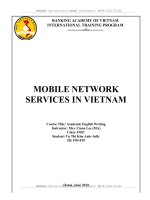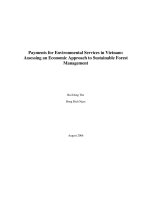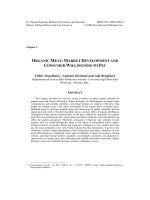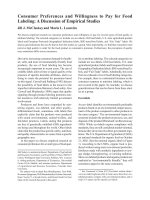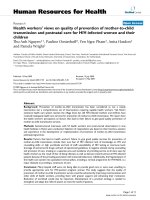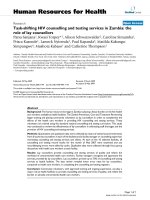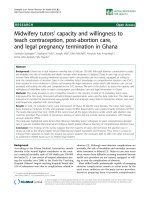Mobilization for HIV Voluntary Counseling and Testing Services in Vietnam Clients’ Risk Behaviors, Attitudes and Willingness to Pay
Bạn đang xem bản rút gọn của tài liệu. Xem và tải ngay bản đầy đủ của tài liệu tại đây (454.42 KB, 11 trang )
AIDS Behav (2016) 20:848–858
DOI 10.1007/s10461-015-1188-6
ORIGINAL PAPER
Mobilization for HIV Voluntary Counseling and Testing Services
in Vietnam: Clients’ Risk Behaviors, Attitudes and Willingness
to Pay
Long Hoang Nguyen1,3 • Bach Xuan Tran1,2 • Nhung Phuong Nguyen5
Huong Thu Thi Phan4 • Trang Thu Bui4 • Carl A. Latkin2
•
Published online: 12 September 2015
Ó Springer Science+Business Media New York 2015
Abstract A multi-site survey was conducted on a sample
of 365 clients to assess their willingness to pay for HIV
voluntary counseling and testing (VCT) services in Ha Noi
and Nam Dinh province, two epicenters of Vietnam. By
using contingent valuation technique, the results showed
that most of respondents (95.1 %) were willing to pay
averagely 155 (95 % CI 132–177) thousands Vietnam
Dong (*US $7.75, 2013) for a VCT service. Clients who
were female, had middle income level, and current opioid
users were willing to pay less; meanwhile clients who had
university level of education were willing to pay more for a
VCT service. The results highlighted the high rate of
willingness to pay for the service at a high amount by VCT
clients. These findings contribute to the implementation of
co-payment scheme for VCT services toward the financial
sustainability of HIV/AIDS programs in Vietnam.
Keywords HIV testing Á Willingness to pay Á Contingent
valuation Á Vietnam
Long Hoang Nguyen and Bach Xuan Tran have equally contributed.
& Bach Xuan Tran
1
Institute for Preventive Medicine and Public Health, Hanoi
Medical University, Hanoi, Vietnam
2
Johns Hopkins Bloomberg School of Public Health, Johns
Hopkins University, Baltimore, MD, USA
3
School of Medicine and Pharmacy, Vietnam National
University, Hanoi, Vietnam
4
Authority of HIV/AIDS Control, Ministry of Health, Hanoi,
Vietnam
5
Hanoi University of Pharmacy, Hanoi, Vietnam
123
Introduction
The HIV epidemic in Vietnam is among those with the
fastest growth in Asia [1]. HIV infection is primarily driven
by high-risk populations in the country (i.e., female sex
workers, injecting drug users, men who have sex with men,
and sexual intimate partners of drug users [2–6]. Approximately 225,000 people were reported to have contracted
HIV [7], but this rate was underestimated due to the fact
that many people are unaware of their HIV-positive status
[6]. In such cases, widespread scale-up of HIV voluntary
counseling and testing services (VCT) is critical to limit the
transmission of HIV.
VCT has been recognized as a cost-effective part of the
overall control strategy of the HIV/AIDS epidemic [8–10].
VCT supports an individual to make an informed choice
about being tested for HIV through counseling [11].
A VCT procedure consists of 4 components: (1) Pre-test
counseling; (2) HIV testing; (3) Post-test counseling; and
(4) Follow-up counseling [12]. Counseling reduce possibilities of HIV infection and transmission through interpreting test results and initiating changes of risk behaviors,
Furthermore, service users are provided referrals to additional care, such as preventive, psychosocial, and other
essential services [11]. VCT is also considered as an entry
point for other HIV/AIDS preventive and treatment
including the prevention of HIV transmission from mother
to child. [11, 13]. VCT may lead to a decrease of risk
behaviors among HIV-positive individuals, such as
unprotected sex [14, 15]. In addition, it enables early
antiretroviral treatment, therefore improves health status
and quality of life of people living with HIV/AIDS
(PLWHA).
VCT service has been used widely in Vietnam through
supports of international donors. Currently, there are 485
AIDS Behav (2016) 20:848–858
VCT sites in 63 provinces nationwide [16]. However,
there are small proportions of high-risk populations
undergoing HIV testing (e.g., 15–32.7 % of female sex
workers [17, 18], 36 % of men who have sex with men
[19] ). Therefore, expanding HIV testing service coverage
to high-risk populations is a high-priority task of the
National HIV/AIDS Strategic Plan in Vietnam in the
period of 2020–2030 [20].
The Vietnamese government is currently confronting
the challenge of ensuring the financial sustainability of
HIV/AIDS programs (including VCT). According to the
projection for the period 2011–2015, the total cost of
HIV services will increase by 60 %, to approximately
US $150 million. However, internal sources can subsidize only 6–12 % of the total cost [21]. In order to
reduce the deficit, the Vietnamese Ministry of Health has
identified potential strategies, such as decreasing cost,
improving efficiency, mobilizing resources [22], and
encouraging users’ co-payments [22]. Accordingly,
information about willingness to pay (WTP) of clients
for VCT will help the government identify appropriate
financial allocations to ensure sustainability of HIV/
AIDS intervention services.
WTP is defined as the largest sum of money that a
customer is amenable to pay in order to obtain a certain
good or service. The measurement of willingness to pay
could be derived by revealed- or stated- preference
approaches. In evaluation of health care intervention, a
stated-preference method that has been widely used is
contingent valuation (CV) [23]. CV is defined as a
survey-based and hypothetical elicitation technique to
estimate WTP values of customers for a service they
receive through their evaluation of hypothetical scenarios [23].
Currently, there has been a little research on WTP for
VCT [24, 25]. This paper aimed to determine the WTP for
VCT and identify the WTP-related factors among Vietnamese clients through a multi-site survey. Results from
the study may inform social mobilization policy for sustainability of HIV/AIDS programs.
Methods
Study Setting and Sampling
This study was a part of ‘‘HIV Service User Survey 2013’’
(HSUS 2013), which evaluated the effects of integrated
HIV-related service delivery models on health and economic outcome of PLWHA in Vietnam. The cross-sectional study was conducted in Hanoi and Nam Dinh from
January to August 2013. These two cities are among the
areas with the largest HIV infection burden in northern
849
region in Vietnam, with 20,762 and 3781 PLWHA in
Hanoi and Nam Dinh, respectively [16]. VCT clinics were
purposively selected based on several following criteria:
(1) providing VCT services; (2) comprising provincial-;
district- and commune-level; (3) implementing HIV-testing
and consultation according to the official guideline of
Vietnam Ministry of Health [26] and (4) representing for
both urban and rural areas. The list of all VCTs meet eligible criteria was prepared and we estimated that 6 sites are
needed to derive a sample of 400 clients. We selected 2
provincial and the only one commune VCT in the sample
frame, and then randomly selected 3 district- VCT sites.
Accordingly, six VCT facilities were selected four sites in
Hanoi, including in 1 provincial site (Hang Bai clinic), 2
district sites (Dong Anh and Hoang Mai district health
centers) and 1 commune site(Truc Bach); two sites in Nam
Dinh, including in 1 provincial site (Nam Dinh HIV/AIDS
control center) and 1 district site (Xuan Truong district
health center).The information of each clinic was described
below:
Name
Level
Location
Other services
Nam Dinh Provincial
AIDS Center
Provincial
Nam Dinh
Methadone
Maintenance
Xuan Truong District
Health Center
District
Nam Dinh
ART/MMT,
General Health
Hang Bai Clinic
Provincial
Hanoi
General Health
Dong Anh District
Health Center
District
Hanoi
ART, General
Health
Hoang Mai District
Health Center
District
Hanoi
ART, General
Health
Truc Bach Commune
Health Station
Commune
Hanoi
General Health
The VCT clients were introduced about the study at
the waiting room by a well-trained interviewer. This
could be either a master student at Hanoi Medical
University or a counselor at the VCT site. The inclusion
criteria included: (1) visiting clinics during the study
period; (2) being age from 18 years or above; and (3)
having capacity and agreement to answer the questionnaires. The VCT clinics were organized following a
national guideline so that they are similar in terms of
service, procedure and facility. Clients may decide to
take VCT in any site if they would like to. During the
period of the study, it is estimated that each site had
about 10–50 clients per month; therefore, we set a
3 months as a duration for data collection. We approached and invited all clients who visited the selected VCT
for the study. Before interviewing, we explained the
123
850
AIDS Behav (2016) 20:848–858
purpose of this study and obtained informed consents
from eligible subjects. The selected individuals were
invited to designated counseling rooms for an interview.
Respondents included both those clients who first come
to take the services or those who returned for taking the
results. To examine if the test results would influence
patients’ preference, we included the HIV-status of clients in the statistical analysis.
Socioeconomic Status
Measures and Instruments
Health-Related Quality of Life
A structured questionnaire was developed to collect the
data of interest. Due to the lack of data about WTP for
VCT, we developed the conceptual framework through a
literature review to identify the determinants of WTP for
VCT services in previous studies. For example, a study of
Ozochukwu underlined the positive role of socio-economic
characteristics (age, gender, education, etc.) and VCT
toward-knowledge and attitude in WTP for VCT. Meanwhile, some studies suggested both positive and negative
relations among socio-economic status, risk behaviors
(sexual activities, condom use, drug use, etc.), health status
and VCT service utilization [18, 27, 28]. The conceptual
framework was figured out in Fig. 1. The variables of
interest were listed below:
Health-related quality of life was measured by using EQ5D-5L instrument, which was validated elsewhere [29].
This instrument assessed five dimensions including
mobility, self-care, usual activities, pain/discomfort and
anxiety/depression [30], with five levels of response: no
problems, slight problems, moderate problems, severe
problems, and extreme problems.
Fig. 1 Conceptual framework
to determine the associated
factors with WTP for VCT
The socio-economic factors included age, gender, marital
status, educational level, employment, and income.
Monthly household income per capita was calculated
through all household members’ incomes. Then, this
income was categorized into five quintiles as ‘‘poorest’’,
‘‘poor’’, ‘‘middle’’, ‘‘rich’’ and ‘‘richest’’.
Sexual Behaviors
Sexual behaviors, such as number and type of partners,
condom use with last sex, and percentage of condom use in
the last 12 months, were investigated. Non-condom use
with last sex was identified when the respondent did not
SocioKnowledge and
economic
Health status
Risk behaviors
attitude
status
- Income
- Health-related
- Knowing
- Unsafe sex,
- Expenditure
quality of life
relatives with
condom use,
- Age
- Mental health
HIV-positive
sexual contact
- Gender
- Physical
- Benefits and
with sex
- Education
health
roles of taking
workers
- Marital status
VCT
- Alcohol use
- Employment
- Importance of
- Drug use:
VCT
history,
- Referral for
concurrent
relatives
Willingness to pay for VCT
123
AIDS Behav (2016) 20:848–858
use condom in the last sex (i.e., primary partners, casual
partners, and sex workers).
Opiate Drug Use Behaviors
Information about illicit opioid (comprising heroin and
other opiates) use included: lifetime opiate drug use, lifetime opiate drug injection, and current opiate drug use.
Current opiate drug user was defined as a person currently
used illicit opioid at the time they took HIV testing and
counseling.
VCT Use and Referral
In this study, metrics about total times of using VCT until
the interview, information about a person who referred
respondents to take initial VCT used and whether or not
respondents referred their partners/relatives to VCT services were collected. In addition, whether VCT clients
were willing to be voluntary peer instructors was also
considered in the study.
To figure out the HIV/AIDS status of clients and their
family members, some approaches were utilized. For
people went to clinics to take test and consultation, we
asked questions about HIV status of their family members,
provided codes to them and then the clients used their
codes to have HIV test. This step would help to ensure the
confidential of clients. When the test results were available,
we matched the codes for the correspond questionnaires.
Otherwise, for people went to clinics to take test results, we
only asked them to report their HIV status without providing codes.
Willingness to Pay for VCT
To support respondents in evaluating their WTP for VCT, a
scenario, containing general information about several
851
aspects of VCT in Vietnam, was provided to ensure that
patients had sufficient background knowledge about VCT.
First, the interviewers reviewed the transmission pathways
of HIV and the benefit of VCT (e.g., knowing HIV/AIDS
status, preventing risk of infection) [11]. Then, they summarized the financial problem related to VCT in the future,
and the national plan in confronting the issues and scalingup the coverage of VCT services [20]. Specifically, surveyors explained that although VCT was current free-ofcharge due to the donation of international sources, that
funding will be decreased and that co-payment from VCT
clients may be essential to maintain the VCT services. For
patients or clients who already used VCT services, they
were asked to imagine that they would have a need to
utilize VCT services in the future. This assumption helped
the participants selecting their options easier.
To elicit WTP for VCT, double-bounded dichotomouschoice questions combined with an open-ended question
were used in the study. To select an initial price, we based
on previous studies about cost per client for VCT in
Vietnam A study showed that the cost per client was from
US $28.4 to US $38.9 in 2007 [31], while another study
reported a much lower cost of US $7.6 in 2012 [31, 32].
The difference may explain by higher number of clients per
setting in the latter study compared to the former one [32].
To adapt the results of those studies and adjust to the
number of VCT clients per site, twenty US dollars (20,000
VND = US $1, 2013 exchange rate) were selected to be an
initial price in the current study.
After understanding the scenario described above, each
patient was asked a number of Yes/No questions about
their willingness to pay specific prices (see bidding process
in Fig. 2). First, they were asked to whether they were
willing to pay US $20 for VCT service. Depending on their
choice, interviewers presented two other bids: the double
bid for respondents answering ‘‘Yes’’; and the half bid for
respondents saying ‘‘No’’. The question was repeated until
Fig. 2 Bidding process of the
contingent valuation method.
N an unwillingness to pay; Y a
willingness to pay
123
852
the last bid was equal to four times or one-eighth of the
initial price. Finally, the respondents were asked an openended question ‘‘What is the maximum price you would be
willing to pay for VCT service?’’.
Statistical Analysis
STATA version 12.0 (Stata Corp. LP, College Station,
United States of America) was used to analyze the data.
Statistical significance set at p \ 0.05. To examine differences in various characteristics among participants across
three healthcare system levels (provincial, district and
commune), ANOVA, Kruskal–wallis and v2 tests were
used. Data about WTP was mixed between censored and
uncensored data due to the combination of double-bounded
and open-ended questions. An average amount of WTP for
VCT in different patient groups was estimated by using an
interval model [33]. Multivariate interval regression was
used to determine factors associated with the amount of
WTP for VCT services. In the model, the amount of WTP
was an outcome variable, while factors such as socioeconomic, health status (EQ-5D), risk behaviors, attitude,
and uses of VCT services were independent variables.
Stepwise backward strategies based on log-likelihood ratio
test were used to construct the reduced model, in which
p values [0.2 was the threshold for exclusion.
Ethical Approval
The research was approved by the Medical Ethical Committee of the Authority for HIV/AIDS Control at the
Vietnamese Ministry of Health.
Results
A total of 365 VCT clients were recruited to the study,
including 38.1 % at provincial clinics and 32.6 % at district ones. Of these, 32.6 % were female, 58.6 % aged
under 35, 64.1 % lived with their spouse, and more than
70 % of the respondents completing high school or above.
Almost all of them were workers/farmers or self-employed
(Table 1).
Self-reported health-related quality of life of clients is
shown in Table 2. Most of the respondents reported problems in Anxiety/Depression (68.2 %). Approximately onethird of subjects reported suffering issues in Mobility and
Pain/Discomfort. Meanwhile, only 8.2 % clients reported
having problems in Self-care.
Regarding risky sexual behaviors, 46.6 % of respondents had one partner in the last twelve months, and 39.2 %
reported more than one partner. Among those who were
sexually active, the proportion of the participants not to use
123
AIDS Behav (2016) 20:848–858
condom in the last sex with their primary partners was the
highest compared with casual sex partners or sex workers.
However, the frequency of using condom with main partners (spouse/beloved) was the highest (mean = 37.2 times
out of 100; SD = 32.3). In addition, one out of ten had a
history of illicit drug use, 6.9 % reported a history of drug
injection, and 4.1 % reported currently use drugs.
(Table 3).
Table 4 shows attitude toward and uses of VCT
amongst respondents. The average frequency of VCT uses
was 1.12, higher at the provincial level than at the commune level. Peers and media were the most frequent
referrers of the first VCT use amongst clients (25.6 and
26.1 %, respectively), while parents/relatives were the
least frequent. HIV prevalence was low in respondents
(4.7 %) but high in their family members (64.7 %). More
than half of the clients would refer to their partners or
relatives to VCT services (60.3 and 51.5 %, correspondingly). However, only one-fourth of people would become
voluntary peer instructors.
The preference and WTP for VCT services is described
in Table 5. Overall, most of the respondents were willing
to pay for VCT (95.1 %) The mean amount they were
willing to pay was 155 thousand Vietnam Dong per utilization (95 % CI 132–177 thousands Vietnam Dong),
equivalent to US $7.75 in 2013, and varied across groups.
Female clients and those clients utilizing VCT at the district or rural clinics were willing to pay less than other
client groups.
Table 6 shows the findings from reduced multivariate
regression to determine factors related with the amount of
WTP for VCT service. Clients were willing to pay a
smaller amount for VCT service if they were female,
current drug users, and belonged to middle income.
Meanwhile, respondents completing university education
were willing to pay a higher price for VCT compared to
those being illiterate.
Discussion
This study indicated the high prevalence of mental and
physical health problems; and sexual risky and illicit drug
use behaviors amongst VCT clients. Most people using
VCT services reported anxiety/depression symptoms. This
may be due to the fact that when someone went to VCT
facilities, they were worried about their HIV status. In
many developing countries, people who are infected with
HIV have to confront not only the decline of health status,
but also the serious stigma and discrimination of the
communities [34]. Moreover, the prevalence of sexual risk
behaviors among VCT clients was still high, while the
AIDS Behav (2016) 20:848–858
Table 1 Characteristics of
VCT clients by level of services
administration
853
Characteristics
Province
District
Commune
N
%
N
%
49
35.3
47
39.5
21
8.5
18
15.1
N
Total
p value*
%
N
%
23
21.5
119
32.6
0.016
16
15.0
39
10.7
0.13
Gender
Female
Age
18–\25
25–\30
27
19.4
20
16.8
29
27.1
76
20.8
30–\35
45
32.4
26
21.9
28
26.2
99
27.1
35–\40
23
16.6
26
21.9
16
15.0
65
17.8
40–\45
16
11.5
16
13.5
11
10.3
43
11.8
C45
18
13.0
18
15.1
7
6.5
43
11.8
25
94
18.0
67.6
27
78
22.7
65.6
31
62
29.0
57.9
83
234
22.7
64.1
Marital status
Single
Live with spouse
Live with partner
6
4.3
3
2.5
5
4.7
14
3.8
Divorced
9
6.5
7
5.9
3
2.8
19
5.2
Widow
5
3.6
4
3.4
6.0
5.61
15
4.1
0.00
Educational attainment
Illiterate
1
0.7
–
–
1
0.9
2
0.6
Elementary
–
–
12
10.1
5
4.7
17
4.7
Secondary
25
18.0
40
33.6
19
17.8
84
23.0
High
44
31.7
39
32.8
49
45.8
132
36.2
Vocational
49
35.3
22
18.5
18
16.8
89
24.4
University
20
14.4
6
5.0
15
14.0
41
11.2
\0.001
Employment
Unemployed
11
7.9
13
10.9
5
4.7
29
8.0
Self-employed
46
33.1
52
43.7
40
37.4
138
37.8
White collars
43
30.9
10
8.4
24
22.4
77
21.1
Workers, farmers
Students
27
6
19.4
4.3
34
1
28.6
0.8
20
10
18.7
9.4
81
17
22.2
4.7
Other jobs
6
4.3
9
7.6
8
7.5
23
6.3
Cult of ancestors
96
69.1
96
80.7
101
94.4
293
80.3
Buddhism
34
24.5
16
13.5
0
0.0
50
13.7
Catholic
9
6.5
7
5.9
5
4.7
21
5.8
Protestant
0
0.0
0
0.0
1
0.9
1
0.3
0.07
Religion
\0.001
*Using Chi squared test
proportion of people reported using illicit drugs was low.
This finding corresponds the changing pattern of HIV
transmission—from injection drug transmission to sexual
transmission in Vietnam [16].
While investigating the attitudes towards VCT, the
study found that peers and media were the most popular
factors that facilitated initial VCT visit of clients. Furthermore, high rates of clients had already referred the
service to their relatives. This finding was similar to other
studies conducted in Ethiopia [35, 36] and Nigeria [37],
indicating that those channels are potential approaches to
expand the benefits of VCT service to population. In
addition, most respondents expressed a WTP for VCT
services.
The observations indicated the noteworthy agreements
of clients about WTP for VCT services, suggesting that
they already perceived benefits of VCT and their responsibility of co-payment. The mean amount of WTP for VCT
in this study was US $7.75. The result was much lower
than the cost per client in the study of Hoang et al. in 2007
(in facility-based VCT: US $30.3; in free-standin g VCT
facility: US $38.9) [31], but approximately equal to the
survey of Nguyen et al. (with US $7.6) in 2012 [32]. This
amount of WTP accounted for 0.41 % GDP per capita in
123
854
AIDS Behav (2016) 20:848–858
Table 2 Health-related quality
of life of VCT Clients
Health status EQ5D profile
Province
District
Commune
Total
N
N
N
N
%
%
%
p value*
%
Mobility
Have problems
No problems
21
15.1
39
32.8
35
32.7
95
26.0
118
84.9
80
67.2
72
67.3
270
74.0
\0.05
Self-care
Have problems
No problems
5
3.6
25
21.0
–
134
96.4
94
79.0
107
–
30
8.2
100.0
335
91.8
\0.001
Usual activities
Have problems
No problems
\0.001
10
7.2
37
31.1
2
1.9
49
13.4
129
92.8
82
68.9
105
98.1
316
86.6
54
85
38.9
61.2
46
73
38.7
61.3
31
76
29.0
71.0
131
234
35.9
64.1
0.21
100
71.9
52
43.7
97
90.7
249
68.2
\0.001
39
28.1
67
56.3
10
9.4
116
31.8
Pain/discomfort
Have problems
No problems
Anxiety/depression
Have problems
No problems
*Using Chi squared test
Table 3 Risk behaviors of VCT clients
Province
Ever had sex
District
N
%
N
%
136
97.84
105
88.24
Commune
Total
p value*
N
%
N
%
106
99.07
347
95.07
0.14
\0.001
Number of sex partners (in the last 12 months)
None
10
7.19
38
31.93
4
3.74
52
14.25
One sex partners
66
47.48
67
56.3
37
34.58
170
46.58
2–3 sex partners
48
34.53
7
5.88
45
42.06
100
27.4
[4 sex partners
15
10.79
7
5.88
21
19.63
43
11.78
124
89.21
84
70.59
98
91.59
306
83.84
\0.001
41
28
29.5
20.14
2
16
1.68
13.45
21
36
19.63
33.64
64
80
17.53
21.92
\0.001
\0.001
62.65
Type of sex partner
Primary partners
Casual sex partners
Sex workers
Condom use with last sex
With primary sex partners (n = 305)
62
50
52
55
56.12
169
55.41
0.20
With casual sex partners (n = 60)
14
36.84
–
–
9
42.86
23
38.33
0.66
8
30.77
16
100.0
11
32.35
35
46.05
\0.001
With sex workers (n = 76)
Mean
SD
Mean
SD
Mean
SD
Mean
SD
Percentage of condom use (in the last 12 months)
With primary sex partners
With casual sex partners
54.2
21.5
39.2
38.1
31.4
–
42.1
–
16.1
65.3
35.0
4.6
37.2
11.8
32.3
28.1
\0.001
\0.001
With sex workers
16.1
35.0
4.4
17.4
65.5
32.6
23.9
35.1
\0.001
N
%
N
%
N
Ever drug use
19.0
13.7
12.0
10.1
7.0
Ever inject drug
15.0
10.8
7.0
5.9
3.0
Current drug use
9.0
47.4
4.0
33.3
2.0
*Using Chi squared test and ANOVA
123
%
N
%
6.5
38.0
10.4
2.8
25.0
6.9
0.04
28.6
15.0
4.1
0.60
0.19
AIDS Behav (2016) 20:848–858
855
Table 4 Attitudes and Uses of VCT services
VCT service utilization (total times)
Province
District
Mean
95 % CI
Mean
1.45
1.03
1.07
N
Referrer of the first VCT used
Spouse
1.88
%
Commune
Total
95 % CI
Mean
95 % CI
Mean
95 % CI
0.77
0.75
0.60
1.12
0.93
N
%
N
1.37
%
0.89
N
p
value*
1.31 \0.05
%
p value*
\0.05
10
12.7
23
37.7
3
4.5
36
17.4
Peers
14
17.7
6
9.8
33
49.3
53
25.6
Health workers
10
12.7
9
14.8
4
6.0
23
11.1
Media
25
31.7
7
11.5
22
32.8
54
26.1
Self-motivation
16
20.3
11
18.0
4
6.0
31
15.0
Parents/relatives
4
5.1
5
8.2
1
1.5
10
4.8
10
7.2
2
1.7
5
4.7
17
4.7
HIV status (positive)
Individual
0.16
Family members
107
77.0
69
58.0
60
56.1
236
64.7
\0.05
Spouse/partners
6
4.3
32
26.9
3
2.8
41
11.2
\0.001
Parents
0
0.0
1
0.8
0
0.0
1
0.3
0.35
Brother/sister
3
2.2
5
4.2
0
0.0
8
2.2
0.1
Other relatives
11
7.9
2
1.6
0
0.0
13
3.5
\0.05
86
61.9
71
59.7
63
58.9
220
60.3
0.88
Refer partners to HIV testing services
Refer other relatives to HIV testing services
75
54.0
58
48.7
55
51.4
188
51.5
0.7
Volunteer to be a peer instructor
28
20.1
29
24.4
38
35.5
95
26.0
\0.05
*Using Chi squared test and ANOVA
Table 5 Willingness to pay for
VCT service
Willing to pay
Amount of WTP (1000 Vietnam Donga)
No.
%
Mean
(95 % CI)
365
347
95.1
155
132
177
Male
246
233
94.7
169
139
198
Female
119
114
95.8
125
91
159
Provincial
139
137
98.6
192
153
232
District
119
106
89.1
97
69
125
Commune
Area
107
104
97.2
169
122
216
Variable
Overall
N
Sex
Level
a
Urban
266
261
98.1
182
153
210
Rural
99
86
86.9
81
53
109
1 USD = 20,000 Vietnam Dong
Vietnam in 2013 (US $1910, according to the statistic of
World Bank) [38], making this amount being acceptable
for the clients to pay. However, a study conducted in
Nigeria indicated that the mean amount of WTP was much
lower (US $3.2) [24], despite of a higher GDP per capita in
Nigeria compared to Vietnam. Additional research conducted in Kenya estimated another amount was US $2 [25].
This can be explained by various factors. First, the cost to
123
856
Table 6 Factors associated
with willingness to pay for VCT
services among Vietnamese
clients
AIDS Behav (2016) 20:848–858
Characteristic
Coef.
p
95 % CI
Employment
Unemployed (ref)
Self-employed
60.43
0.11
-13.65
134.51
White collars
58.27
0.19
-29.21
145.75
-97.43
0.02
-177.19
-17.66
-122.88
0.19
-306.64
60.88
-164.48
0.12
-368.75
39.80
129.35
0.11
-27.63
286.34
-103.70
\0.01
-174.14
-33.27
117.89
0.02
17.73
218.05
-140.78
0.03
-269.35
-12.21
193.74
\0.01
133.51
253.97
Income per capita
Poorest (ref)
Middle
Condom use with Spouse/Partner
Yes (ref)
Unknown
Brother/Sister have HIV positive
Yes (ref)
No
Referrer of the first VCT used
Spouse (ref)
Parents/Relatives
Gender (Female vs. Male)
Male (ref)
Female
Education
Illiterate (ref)
University
Current drug use
No (ref)
Yes
Constant
operate VCT centers in those areas was lower than in
Vietnam [25, 31]. Second, respondents engaged in highrisk behaviors in concentrated epidemics like Vietnam may
perceive importance and necessity of VCT than those in
generalized epidemics [39, 40]. Finally, in reference settings, respondents believed that these services should have
been provided without charge [24].
This study also identified differences of mean WTP
amounts in various health service system levels. While the
clients were inclined to spend approximately US $10 at the
provincial and commune clinics, US $5 was the maximum
amount a customer was amenable to sacrifice at the district
levels. It might reflect that the clients were not satisfied
with the quality of services (e.g., counseling procedure,
clinics’ facilities and/or the ability of health staffs, etc.) at
those centers and they did not want to pay more. Additionally, the finding that male clients and people with
university education were willing to pay more than the
others is consistent with a previous study [24].
Nonetheless, the respondents with middle income per
capita were willing to pay less than the poorest group.
123
Normally, people with higher income are willing to pay
more [41, 42]. Notably, when analyzing the data more
deeply for the frequency of having HIV-test according to
levels of income (data not shown), we observed the
higher rate of people not taking HIV-test before the
interview in the lowest income quintile compared to
that in other levels. When using contingent valuation
approach, this phenomenon had to be concerned as a lack
of familiarity in VCT service utilization may lead to
hypothetical bias. Previous literature emphasized the role
of familiarity characteristic that people having insufficient
experience for unfamiliar goods tended to overestimate
their WTP [43].
The result also found that current drug users were
willing to pay less than others. Some current drug users
may avoid using health care services including HIV testing.
Besides, a previous study reported that monthly spend of
drug users for opiates were US $540, which were five times
higher than their average income per capita [41]. This
expenditure places economic burden on households, which
may affect the WTP of respondents.
AIDS Behav (2016) 20:848–858
The study has several implications. First, the high
prevalence of sexual-risk behaviors (e.g., multiple partners,
inconsistent condom use) implied the need for counseling
and education about the role of safe sex in preventing HIV
infection. Second, clients themselves and media (television, radio, etc.) were demonstrated as potential channels to
disseminate benefits of VCT service to this vulnerable
population. Third, the study indicated the possibility of copayment implementation to ensure the sustainability of
HIV/AIDS programs regarding the proportion of respondents accepting to pay for VCT and their mean WTP
amount. [32]. Finally, since the WTP of high-risk populations such as female [5] or current drug users was observed
to be lower than other subjects, a subsidy or incentives for
those populations should be taken into consideration.
Apart from investigating WTP, some suggestions are
drawn to reduce the cost and to address the financial sustainability of VCT services. The government should set up
different VCT delivery models in appropriate locations,
such as stand-alone VCT units were placed in the areas
with a high prevalence of HIV/AIDS while integration
facilities were established in low-risk areas [41, 44]. It is
noteworthy that freestanding VCT facilities required much
more resources than integration model [31]. The study in
Kenya showed an amount of US $8 per client may be
reduced if general health staffs could play a role as HIV
counselor [25]. Health insurance is also a considerable
approach to tackle the issue. However, ensuring the equity
and financial balance for other chronic diseases are great
challenges [45].
The strengths of this study lie in various settings in two
Vietnamese epicenters. Clients were provided basic background of VCT and the current situation of financial
problem for VCT before asking the WTP, thus their
responses may reflect their true opinions about the issue,
which lead to reliable results. Additionally, contingent
valuation method and multivariate interval regression were
used appropriately to improve the estimation of WTP by
mixing censored and uncensored data [33]. However, the
research has several limitations. Firstly, the generalization
of our results was limited due to the convenience sampling.
We acknowledge the limitation that we include only 2
provinces with a small number of clients in this study, and
would like to notice readers to be cautious in the application of our research findings. Secondly, a small sample size
was used in the study, which may result in the deficiency of
statistical power. Finally, contingent valuation is a subject
measure, which may lead to the uncontrolled bias. For
example, people regularly respond to the bids that are
benefit for them [46]. To diminish this issue, the purpose of
study as well as the confidentiality of clients was clearly
explained before the interview.
857
In conclusion, the rates of WTP and the amount that
Vietnamese clients were willing to pay were higher,
compared to other studies. The findings are partly contributed to the implementation of co-payment policy
toward the sustainability of HIV/AIDS interventions in
Vietnam.
Acknowledgments Dr Bach Tran received the joint fellowship of
the International AIDS Society and the National Institute on Drug
Abuse that encourages HIV and drug use research. The study was
funded by Vietnam Authority of HIV/AIDS Control. We would also
like to thank all research managers, staffs and health professionals in
Ha Noi and Nam Dinh Provinces for the tremendous supports in
implementing the study.
Compliance with Ethical Standards
Compete of interest
None.
References
1. UNAIDS. Report on the global AIDS epidemic. Geneva:
UNAIDS; 2008.
2. Tran BX, Ohinmaa A, Nguyen LT, Oosterhoff P, Vu PX, Vu TV,
et al. Gender differences in quality of life outcomes of HIV/AIDS
treatment in the latent feminization of HIV epidemics in Vietnam. AIDS care. 2012;24(10):1187–96.
3. Do TN, Nguyen TM, Do MH, Masaya K, Dang TB, Pham TL, et al.
Combining cohort analysis and monitoring of HIV early-warning
indicators of drug resistance to assess antiretroviral therapy services in Vietnam. Clin Infect Dis. 2012;54(Suppl 4):S306–12.
4. Tran BX, Nguyen NP. Patient satisfaction with HIV/AIDS care
and treatment in the decentralization of services delivery in
Vietnam. PLoS One. 2012;7(10):e46680.
5. Nguyen TA, Oosterhoff P, Hardon A, Tran HN, Coutinho RA,
Wright P. A hidden HIV epidemic among women in Vietnam.
BMC Public Health. 2008;8:37.
6. Control VAoHA. Vietnam HIV/AIDS estimates and projections
2011–2015. Hanoi: Ministry of Health; 2013.
7. Control VAoHA. The review of HIV/AIDS control and prevention until 30/9/2014. Hanoi: Ministry of Health; 2014.
8. Tromp N, Siregar A, Leuwol B, Komarudin D, van der Ven A,
van Crevel R, et al. Cost-effectiveness of scaling up voluntary
counselling and testing in West-Java, Indonesia. Acta Med
Indones. 2013;45(1):17–25.
9. Mulogo EM, Batwala V, Nuwaha F, Aden AS, Baine OS. Cost
effectiveness of facility and home based HIV voluntary counseling and testing strategies in rural Uganda. Afr Health Sci.
2013;13(2):423–9.
10. UNAIDS. HIV Voluntary Counselling and Testing: a gateway to
prevention and care. Geneva: UNAIDS; 2002.
11. UNAIDS. Voluntary Counselling and Testing (VCT). 2000.
12. Health Mo. Decision on promulgation of voluntary HIV counselling and testing (VCT) guidelines. Hanoi 2007.
13. Organisation WH. Investing in a comprehensive health sector
response to HIV/AIDS—scaling up treatment and accelerating
prevention.
14. Merson MH, Dayton JM, O’Reilly K. Effectiveness of HIV
prevention interventions in developing countries. Aids.
2000;14(Suppl 2):S68–84.
123
858
15. Allen S, Meinzen-Derr J, Kautzman M, Zulu I, Trask S, Fideli U,
et al. Sexual behavior of HIV discordant couples after HIV
counseling and testing. Aids. 2003;17(5):733–40.
16. Control VAoHA. The annual review of HIV/AIDS control and
prevention in 2013 and action plan in 2014. Hanoi: Ministry of
Health; 2014.
17. Grayman JH, Nhan DT, Huong PT, Jenkins RA, Carey JW, West
GR, et al. Factors associated with HIV testing, condom use, and
sexually transmitted infections among female sex workers in Nha
Trang, Vietnam. AIDS Behav. 2005;9(1):41–51.
18. Tran BX, Nguyen LT, Nguyen NP, Phan HT. HIV voluntary
testing and perceived risk among female sex workers in the
Mekong Delta region of Vietnam. Glob Health Action.
2013;6:20690.
19. Bengtsson L, Lu X, Liljeros F, Thanh HH, Thorson A. Strong
propensity for HIV transmission among men who have sex with
men in Vietnam: behavioural data and sexual network modelling.
BMJ Open. 2014;4(1):e003526.
20. National Committee for AIDS DaPPaC. National Strategy on
HIV/AIDS Prevention and Control toward 2020 and the vision to
2030. Hanoi 2012.
21. Bach TX. Budget impact of scaling up HIV/AIDS interventions
in Vietnam 2011–2020. Hai Phong: Vietnam Health Policy
Forum; 2011.
22. Ensuring finance for HIV/AIDS prevention and control activities
in the period 2013–2020 (2013).
23. Klose T. The contingent valuation method in health care. Health
Policy. 1999;47(2):97–123.
24. Uzochukwu B, Uguru N, Ezeoke U, Onwujekwe O, Sibeudu T.
Voluntary counseling and testing (VCT) for HIV/AIDS: a study
of the knowledge, awareness and willingness to pay for VCT
among students in tertiary institutions in Enugu State Nigeria.
Health Policy. 2011;99(3):277–84.
25. Forsythe S, Arthur G, Ngatia G, Mutemi R, Odhiambo J, Gilks C.
Assessing the cost and willingness to pay for voluntary HIV
counselling and testing in Kenya. Health Policy Plan.
2002;17(2):187–95.
26. Decision No. 647/QD-BYT of 22 February 2007 on promulgation
of voluntary HIV counseling and testing (VCT) guidelines,
(2007).
27. Wringe A, Isingo R, Urassa M, Maiseli G, Manyalla R, Changalucha J, et al. Uptake of HIV voluntary counselling and testing
services in rural Tanzania: implications for effective HIV prevention and equitable access to treatment. Trop Med Int Health.
2008;13(3):319–27.
28. Ma W, Detels R, Feng Y, Wu Z, Shen L, Li Y, et al. Acceptance
of and barriers to voluntary HIV counselling and testing among
adults in Guizhou province, China. Aids. 2007;21(Suppl
8):S129–35.
29. Tran BX, Ohinmaa A, Nguyen LT. Quality of life profile and
psychometric properties of the EQ-5D-5L in HIV/AIDS patients.
Health Qual Life Outcomes. 2012;10:132.
30. Group E. EQ-5D-5L User guide: basic information on how to use
the EQ-5D-5L instrument Rotterdam, The Netherlands 2011
123
AIDS Behav (2016) 20:848–858
31.
32.
33.
34.
35.
36.
37.
38.
39.
40.
41.
42.
43.
44.
45.
46.
[cited 2013 1-9]. />Documenten/PDF/Folders_Flyers/UserGuide_EQ-5D-5L.pdf.
Minh HV, Bach TX, Mai NY, Wright P. The cost of providing
HIV/AIDS counseling and testing services in Vietnam. Value
Health Reg. 2012;1:36–40.
Nguyen VT, Nguyen HT, Nguyen QC, Duong PT, West G.
Expenditure analysis of HIV testing and counseling services
using the cascade framework in Vietnam. PLoS One.
2015;10(5):e0126659.
Mahieu PA, Riera P, Giergiczny M. Determinants of willingnessto-pay for water pollution abatement: a point and interval data
payment card application. J Environ Manag. 2012;108:49–53.
Genberg BL, Kawichai S, Chingono A, Sendah M, Chariyalertsak
S, Konda KA, et al. Assessing HIV/AIDS stigma and discrimination in developing countries. AIDS Behav. 2008;12(5):772–80.
Addis Z, Yalew A, Shiferaw Y, Alemu A, Birhan W, Mathewose
B, et al. Knowledge, attitude and practice towards voluntary
counseling and testing among university students in North West
Ethiopia: a cross sectional study. BMC Public Health.
2013;13:714.
Regassa N, Kedir S. Attitudes and practices on HIV preventions
among students of higher education institutions in Ethiopia: the
case of Addis Ababa University. East Afr J Public Health.
2011;8(2):141–54.
Iliyasu Z, Abubakar IS, Kabir M, Aliyu MH. Knowledge of HIV/
AIDS and attitude towards voluntary counseling and testing
among adults. J Natl Med Assoc. 2006;98(12):1917–22.
Bank TW. GDP per capita (current US$): Vietnam 2014 [20-062015]. />Wringe A, Isidingo R, Urassa M, Todd J, Mbata D, Maiseli G.
Trends in uptake of voluntary counseling and testing for HIV in
rural Tanzania under widely provision of HIV treatments. Trop
Med Int Health. 2007;17(8):e15–25.
Tewabe T, Destaw B, Admassu M, Abera B. Assessment of
factors associated with voluntary counselling and testing uptake
among students in Bahir Dar University Ethiopia. Ethiop J Health
Dev. 2012;26(1):16–21.
Tran BX. Willingness to pay for methadone maintenance treatment in Vietnamese epicentres of injection-drug-driven HIV
infection. Bull World Health Organ. 2013;91(7):475–82.
Tang CH, Liu JT, Chang CW, Chang WY. Willingness to pay for
drug abuse treatment: results from a contingent valuation study in
Taiwan. Health Policy. 2007;82(2):251–62.
Mohammed EY. Contingent valuation responses and hypothetical
bias: mitigation effects of certainty question, cheap talk, and
pledging. Environ Econ. 2012;3(3):62–71.
Mn L. Comparison of facility-based and free-standing VCT services in Vietnam. Hanoi: Vietnam Ministry of Health; 2002.
Vassall A, Remme M, Watts C, Hallett T, Siapka M, Vickerman
P, et al. Financing essential HIV services: a new economic
agenda. PLoS Med. 2013;10(12):e1001567.
Lang HC. Willingness to pay for lung cancer treatment. Value
Health. 2010;13(6):743–9.
